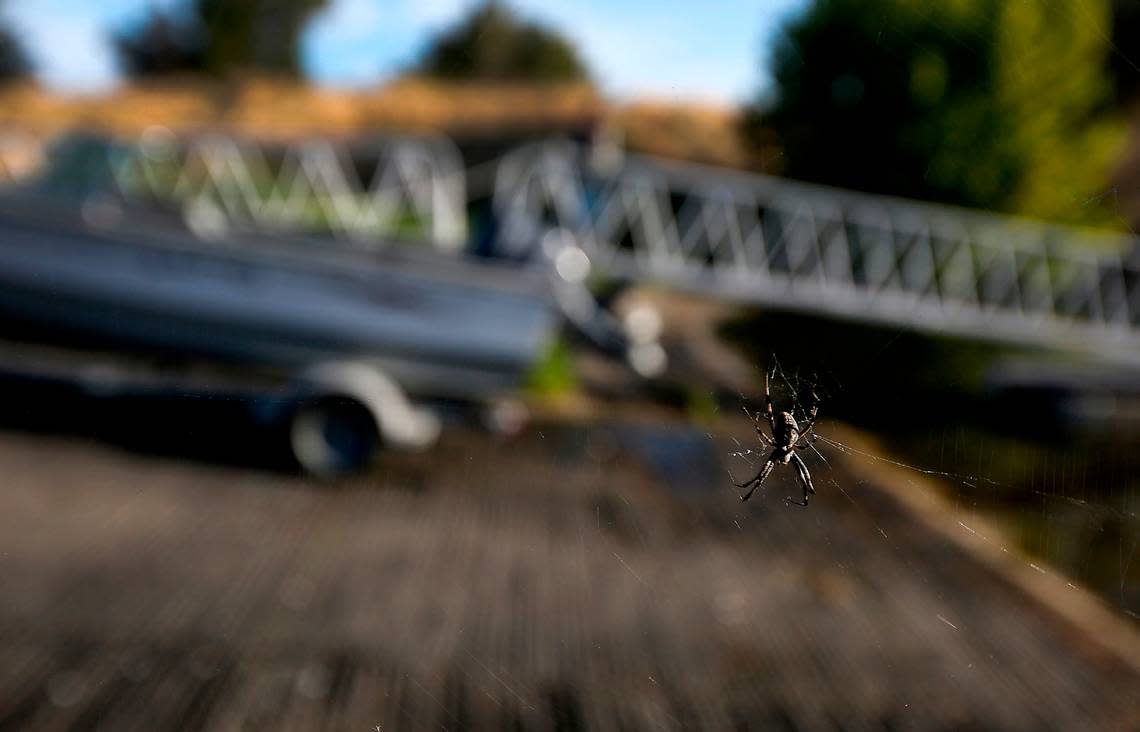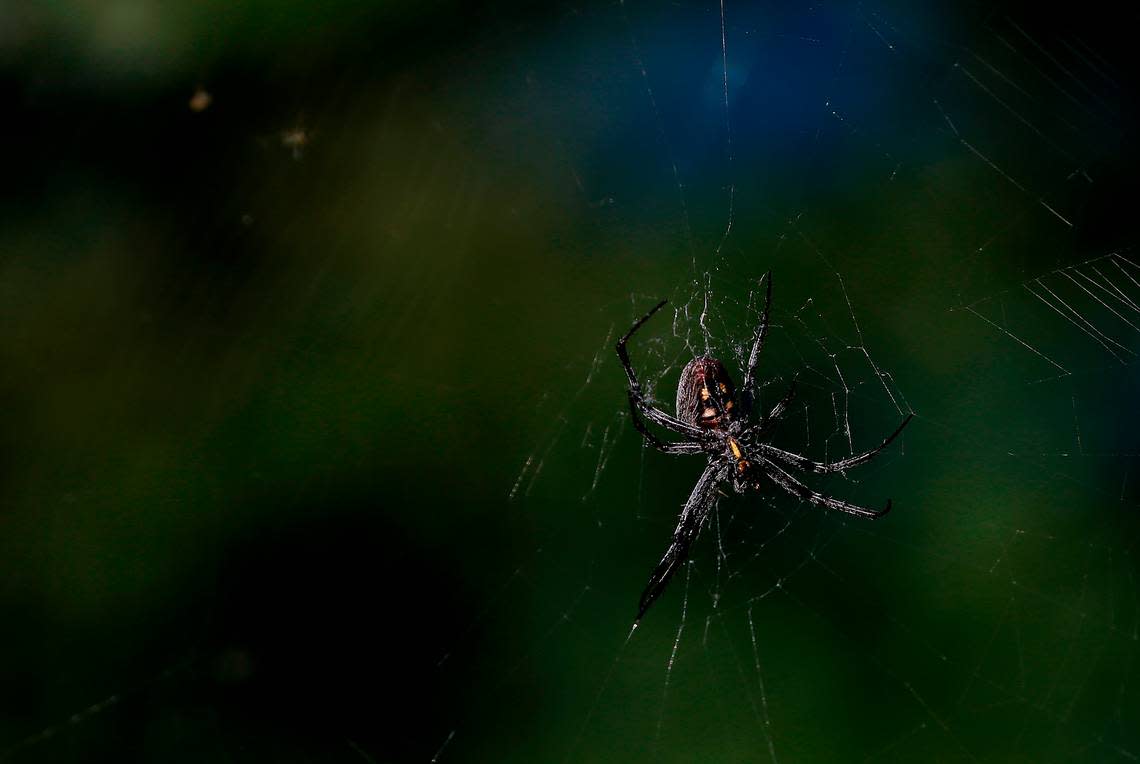Think you’re seeing more spiders in the Tri-Cities? Here’s why, says WA spider expert
If you think you are seeing more spiders inside your Tri-Cities home because of the cooling weather, you’re wrong, says Washington spider expert Rod Crawford.
“Everything that ‘everybody knows’ about spiders is wrong,” Crawford says on the Spiders Myths online page of the Burke Museum in Seattle.
But there may be one thing you are right about.
If you think you’ve been seeing more spiders along the Columbia River in the Tri-Cities starting in early September, you’re right.
For about three weeks in late summer and early fall, orb weaver spiders are particularly visible, spinning their wheel-shaped webs.
But whether there are more than usual for a Tri-Cities September is up for debate.

The spider population varies with weather and prey available and that can change neighborhood to neighborhood.
But every year “I have never failed to have someone ask me why there are more spiders than usual,” Crawford said.
Indoors there are some species of spider that seem to appear with the end of summer.
Indoor vs outdoor spiders
But it is a myth that they they are coming indoors because of cooling weather, Crawford said.
“Outdoor spiders and the commonly seen indoor spiders are not the same species,” he said.

If you periodically see more spiders indoors what you are observing is mating season, Mature male spiders that have been living in your house are wandering in search of mates, he says on the Burke Museum website.
For most of the year female and immature spiders are hidden inside your house in quiet places — crawl spaces, storage areas, behind furniture, and in wall and floor voids, Crawford posts.
The spider ancestors of those you are seeing may have arrived inside via egg sacs on building materials and on items like furniture brought inside the house.
At most 5% of spiders you may see indoors have wandered in from the outdoors, Crawford said.
Most soon die indoors and are in no way attracted to warmth.
“Remember they are ‘cold-blooded’,” he said.
Indoor spiders are adapted to a constant indoor climate and a poor food and water supply.
If you thoughtfully carry spiders outdoors when you find them inside your house, you’re likely not helping most of them, Crawford said.

“You can’t put house spiders ‘back outside’ because they were never outside in their lives and most wouldn’t do well there,” he said.
If you see a bloom of spiders indoors, it should last just two or three weeks, he said. Mating season is short.
And almost all spiders you see are harmless, he said.
How dangerous are spiders?
The Washington state Department of Health considers just two spiders in the state of medical significance — black widow spiders and yellow sac spiders.
Brown recluse spiders, with bites that cause a severe wound with dying body tissue, are not a worry. They don’t live in Washington state, both the Department of Health and Crawford agreed.
“There are zero within 1,000 miles of our state,” Crawford said.
Instead they live in about 15 states, centering around Missouri, he said.

Black widow spiders, however, are native to the state and are most common in Eastern Washington, according to the state agency.
You may find them outdoors in dark areas of woodpiles, hay bales, water meter boxes, under eves and on fences.
Indoors they are less common. They like undisturbed spaces, such as cluttered areas of basements, crawl spaces and unused areas of garages.
True black widows are glossy black with a red or yellowish-orange mark. If you think it is a black widow, but don’t see the mark, it may be a false black widow spider with venom less toxic than the black widow, according to the state.

Yellow sac spiders are found across the state and are mostly outdoor spiders. If you do find one indoors, it may have build a small silken sac to hide in during the daytime.
They are light colored — yellow, white or even greenish — and are a quarter to a half inch long.
But Crawford disagrees with the state that they are medically dangerous.
At one time it was believed that their bites could case skin lesions.
But more recent analyses have shown that while their bites are acutely painful, once the pain is gone there is no acutely harmful affect, he said.
Hobo spiders also may incorrectly be considered a threat to humans. But both Crawford and the state agree that there is no evidence that the bites of the shy and retiring hobo spider cause skin necrosis.
Spider bites uncommon
Black spiders, while a medical concern, are not exactly public enemy No. 1, Crawford said.
It’s been a long time since there has been even one proven death from a black widow bite, he said.
In fact, most people are bitten by a spider just once or twice in a lifetime, according to Crawford’s Burke Museum web page.

Spiders typically “have no reason to bite a human or any other animal too large for them to eat,” he posts.
In many decades as a spider expert, handling tens of thousands of live spiders, he has only been bitten three times, he said. Each time the affect was insignificant, he said.
Blaming every mystery skin bump or sore on a spider bit is not only incorrect, but can be dangerous, he said.
Instead, they could be caused by a serious condition such as skin cancer, necrotizing fasciitis or MRSA, an infection caused by a type of bacteria that is resistant to some antibiotics, and should be checked out by a doctor if they persist.
As for the spiders that have been weaving their webs in the Tri-Cities riverside parks this past month, Crawford says park users should be grateful.
Park orb weaver spiders
They likely are feeding on clouds of gnats along the river and pests from nearby gardens, particularly aphids.
They develop wings in the fall, allowing orb weaver spiders to capture large numbers of them.
Orb weavers are conspicuous when they are mature because “large orb webs are in your face,” unlike more numbers cob, funnel and sheet webs, Crawford said.

Posts about the abundance of orb weavers, particularly those in Tri-Cities riverside parks, started popping up on social media several weeks ago.
“Check benches before sitting,” advised one person about Leslie Groves Park. Another said a western spotted orb weaver has dropped out of a tree onto her glasses.
“The walkways onto the docks of the Leslie Groves boat launch are literally covered in them. And they’re gigantic,” said another post.
“Creepy but cool,” posted another person.
But some people said they welcome seeing the orb weaver spiders in the park to keep populations of flies and mosquitoes in check.
City of Richland crews do spray pesticides to control the spider population in parks.
“While they are unsettling they are not a threat,” the city said in a statement.
This should be the end of the intense activity by orb weavers, which usually lasts about three weeks, according to the city.
